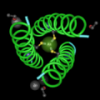I mean phone call. Because, if I thought he remembered me, I would call and say "thank you."
Because of the time I spent in his lab, I know that cloning started long before Dolly. The first vertebrate animal was cloned over 50 years ago.
And it wasn't a sheep.
Raising Rana pipiens
Several years ago, I had the good fortune to work as a student intern for one of the kings of cloning, Robert McKinnell, now an emeritus professor in the Cell Biology and Genetics Department at the University of Minnesota. Reminiscing on history a bit, reminds me how grateful I am that he gave me the chance to work in his lab raising tadpoles, growing tumors, and doing surgery on frogs. I didn't really understand much at the time about the work that was going on, and he was on sabbatical most of the time, but I learned more than I realized and got started for better or worse on the path to graduate school and beyond.
Robert McKinnell was one of the first people to get involved in cloning. He began cloning frogs in 1960's in order to explore questions about development and the ability of an embryonic cell to differentiate into multiple kinds of tissues (1).
These are still important questions.
If we knew more about cellular development and control, we might be able to accomplish some much-desired and currently unattainable goals, like growing new organs, regenerating paralyzed nerves, or regenerating amputated limbs. It is important to note that cloning research has done far more than give us cute cloned puppies and sad stories about Korean scientists. We have gained insights from cloning experiments that have greatly increased our understanding of cancer, cell cycle regulation, and stem cell technology. Cloning is an important a tool for building a stronger knowledge base, one that may even make those much-desired goals become attainable.
1. R.G. McKinnell "Intraspecific nuclear transplantation in frogs." 1962. J Hered.53:199-208.
technorati tags: cloning, frogs, developmental biology

Yes, and we've had McKinnell out to give seminars on cloning to our students a few times. He's a good guy who gives an interesting talk.
He was a great teacher!! I volunteered to work in his lab after I took his "Biology of Cancer Class." I had to buy a dictionary to understand the textbook but the class was so fascinating that it made me want to work at understanding it.
Yeah! he was a really great teacher!